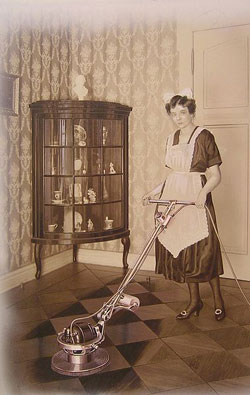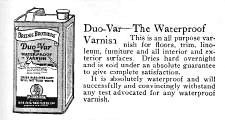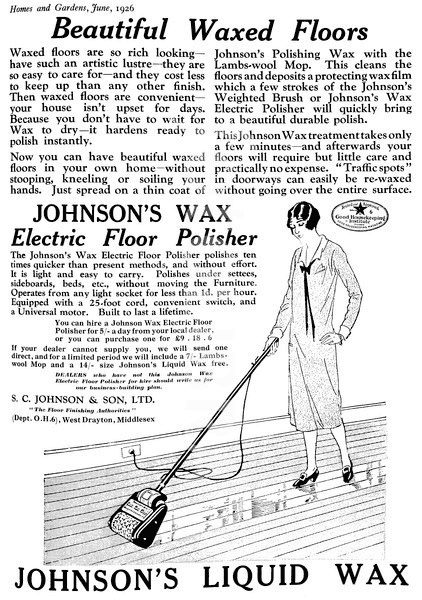Small Home Gazette, Summer 2012
Answers to Your Toughest Bungalow Questions: refinishing wooden floors
The information below was written by Kadee Macey, owner of the St. Paul hardwood flooring equipment rental and contracting firm, Pete’s Hardwood Floors. Additional comments are from Tom Marzolf, a carpenter and floor refinisher with his own business, Golden Rule Home Services.
A: While we applaud your desire to keep your home’s history in mind, there are reasons why many of the early floor coatings have fallen out of favor. It is still possible to coat your floor with what was used in 1925 but it will take effort and time to maintain that finish. Also, whether you are chemically sensitive or not, you should be aware of the solvent bases of the various finishes because they can have health and environmental consequences. Let’s take a look at your options.
Shellac
Shellac is one of the oldest film-building or surface finishes; the kind that leaves a layer of protective solids over a wood floor. Shellac is the hardened, natural secretions of a tropical insect, the lac bug, which are dissolved in denatured alcohol. Liquid shellac can be spread over a floor, leaving behind solids in an even layer as the solvent evaporates.
Shellac is an historically correct option because it was a popular wood and furniture finish starting in the 19th century. While lacquer began to replace shellac for furniture finishing in about 1920, shellac was still used on floors for many more years.
Shellac is still available, ready-mixed from any paint store, or you can buy the dry flakes (online or at a high-end woodworking store such as Rockler) and mix them yourself with denatured alcohol. The color of shellac flakes ranges from blond to orange to garnet, but unfortunately they tend to make the ready-mixed shellac only in orange. Also available as “bleached” to leave wood as pale as possible, it is doubtful bleached shellac was marketed in the bungalow era. Shellac has some good qualities: it adds a beautiful color to wood; has excellent depth and clarity; dries quickly; and can be easy to spot-fix. But shellac makes a poor floor finish and always has. Shellac is considered an evaporative finish, which means the solids that are left behind after the solvent evaporates never truly harden—they just dry. You can easily re-dissolve shellac by pouring denatured alcohol on it. Lac solids are vulnerable to household alcohols like perfume and wine and are prone to white spots from many liquids, including water.
 The finish is not resistant to the abrasion of shoe traffic. Because of this, almost all shellac floors were kept waxed. Several well-maintained layers of wax provided a smooth, deflective layer that helped reduce the appearance of scuffs and scratches on shellac floors, but the human cost of maintaining that wax surface was considerable. Even liquid waxes needed to be buffed on and polished at least weekly to retain an even sheen. If the housewife didn’t have the luxury of an electric buffer, buffing was done by hand.
The finish is not resistant to the abrasion of shoe traffic. Because of this, almost all shellac floors were kept waxed. Several well-maintained layers of wax provided a smooth, deflective layer that helped reduce the appearance of scuffs and scratches on shellac floors, but the human cost of maintaining that wax surface was considerable. Even liquid waxes needed to be buffed on and polished at least weekly to retain an even sheen. If the housewife didn’t have the luxury of an electric buffer, buffing was done by hand.
Denatured alcohol is classified as hazardous under OSHA regulations. The vapors are harmful to the central nervous system, and they are flammable. But the actual ‘lac’ substance that forms the protective barrier after the denatured alcohol evaporates is not considered toxic.
Varnish
Varnish is an enormous category of finishes that was readily available in the 1920s and ’30s. Technically, a varnish is any resin dissolved into an oil using heat. Most varnishes also contain large quantities of paint thinner to keep the resins dissolved until they are spread onto a surface. The resulting substance cures or hardens when exposed to oxygen in the air, making it a durable finish—once it’s cured, it cannot be easily re-dissolved.This was progress over shellac because you could spill your Roaring Twenties gin on varnish without harming it!
 We know that varnish was used on some bungalow floors because all the Sears kit homes were shipped with varnish as part of the total house package. The varnish that our grandparents used is not available to you because those turn-of-the-century varnishes had serious drawbacks: the resins available in the 1920s and ’30s darkened quickly and significantly over time, sometimes becoming almost brown. And because they tended to be brittle and dented easily, homeowners felt the need to wax them as well, which added all the attendant wax-maintenance headaches. The frequency with which hardwood floors (bungalow or otherwise) were covered with carpet in the ’40s, ’50s and ’60s speaks to how frustrating and exhausting the bungalow era floor finishes were to maintain.
We know that varnish was used on some bungalow floors because all the Sears kit homes were shipped with varnish as part of the total house package. The varnish that our grandparents used is not available to you because those turn-of-the-century varnishes had serious drawbacks: the resins available in the 1920s and ’30s darkened quickly and significantly over time, sometimes becoming almost brown. And because they tended to be brittle and dented easily, homeowners felt the need to wax them as well, which added all the attendant wax-maintenance headaches. The frequency with which hardwood floors (bungalow or otherwise) were covered with carpet in the ’40s, ’50s and ’60s speaks to how frustrating and exhausting the bungalow era floor finishes were to maintain.
Paint thinner (the most common solvent for both old and modern varnishes) is a known neurotoxin, a poison that acts on the nervous system, and respirators must be worn during the application process. Anyone with a sensitive respiratory system should stay away during the coating period and not return until at least two days after the final coat is applied.
Stains and Waxes
 What about stain plus wax or stain plus varnish AND wax? Penetrating finishes, like stain, provided pigment that soaked into the wood without any buildup on the surface and were popular when bungalows were built. While stain changed the color of the wood, it did not protect it, so varnish or wax (or both) was applied over the top. Often, woodwork and floors were stained the same color and protected by varnish and, over time, the varnish darkened significantly. This gives the impression that dark-stained trim and floors are the only historically correct option. Tom Marzolf of Golden Rule Home Services argues that while floors were often matched to the wood trim, the stain colors chosen were probably lighter than we think.
What about stain plus wax or stain plus varnish AND wax? Penetrating finishes, like stain, provided pigment that soaked into the wood without any buildup on the surface and were popular when bungalows were built. While stain changed the color of the wood, it did not protect it, so varnish or wax (or both) was applied over the top. Often, woodwork and floors were stained the same color and protected by varnish and, over time, the varnish darkened significantly. This gives the impression that dark-stained trim and floors are the only historically correct option. Tom Marzolf of Golden Rule Home Services argues that while floors were often matched to the wood trim, the stain colors chosen were probably lighter than we think.
The simplest, old-style stains were mainly paint thinner and pigment, which are still manufactured. Environmental regulations are making it harder to sell products with large percentages of paint thinner, so most historically correct stains are also the most polluting and the most harmful to your body. Because stains contain only pigment and no solids or resins of any kind, they will scuff off almost immediately, so even modern stains need to be protected with a finish.
We’ve looked at all the finishing options that were popular when bungalows were built, but none of them are really compatible with a 21st century lifestyle. The good news is that modern materials can produce a look that is very close to that of shellac plus wax or varnish plus wax, with a far more realistic maintenance profile.
Oil-based Polyurethane
Modern oil-based polyurethane IS a varnish and many consider it historically correct. Those old-school varnishes have evolved into the polyurethanes of today. These finishes still start with a resin cooked with an oil, but the resins have become more abrasion resistant and less brittle. The color is a consistent, stable, warm, amber hue, and a variety of sheens is available, allowing you to control the surface gloss without the arduous application of wax. Marzolf points out that the tougher more flexible resins of oil-based polyurethanes are particularly important if you keep pets, so that when your St. Bernard presses his claws into the floor, the finish stretches down into the depression, rather than scraping off.
Three layers of an oil-based polyurethane with a semi-gloss sheen will re-create the color and polish of freshly polished wax without the constant buffing. Polyurethanes should be top-coated every three to five years. If you prefer a deeper color, the floor can be stained prior to applying the polyurethane. This procedure would be historically consistent with the original treatment of those bungalow floors.
The biggest drawback of oil-based polyurethane, despite being the best choice historically and practically speaking, is that coating the average-sized bedroom will release three to four pounds of volatile organic compounds into the air. We can argue about whether this affects global warming and the Earth’s environment, but there is no question that it compromises the homeowner’s immediate environment. No one should sleep in a house on the days when its floors are being coated, not even pets.
Water-based Polyurethane
What about water-based (technically waterborne) polyurethane? Due to increasingly strict environmental air quality regulations in many states (though not in Minnesota at this time), most floor finish manufacturers have been putting their research and development money into water-based finishes. As a result, the quality and ease of use of this comparatively new class of finishes has soared over the past 15 years. So, if you have any kind of chemical sensitivity and must be present during the coating process, water-based finishes will be a better choice than oil-based. Many of my customers are skeptical about the quality of these finishes, but they are the future of wood floor protection. The newest water-based finishes produce a particularly flexible, contiguous sheet of protection over the relative unevenness of an older hardwood floor.
From an historic perspective though, the water-based finishes might not be your best choice. The resins in waterborne finishes have no color whatsoever. None. As a result, most woods, particularly oaks, will appear flatter. Any color comes from the inherent color of the wood used in your floor. However, health concerns should always trump historic ones, and oil-based polyurethanes, while they do replicate the historic finishes very well, are dissolved in paint thinner, which is a known neurotoxin.
Why can’t color be added to water-based polyurethane? With all the innovations in the floor finishing industry, they haven’t been able to replicate the color and patina of an oil-based polyurethane. The difficulty apparently lies in getting the necessary quantity of color to stay evenly dispersed in the finish; it tends to come out looking like cheap sunless tanner. There are some water-based sealers, applied like a primer before the polyurethane to control tannin bleed and prevent other problems, that have pigments added in an attempt to replicate that warm, oil-based color, but they never quite achieve it. A better option would be to use a finish line (BonaKemi, for example) that allows an oil-based stain to be applied safely underneath the layers of water-based polyurethane. But be careful to stay within the manufacturer’s guidelines, most oil-based stains are not designed to be compatible with a topcoat of a water-based finish.
So, when you think about it, today’s products work within the bungalow spirit of living a life where health, simplicity and artistry harmonize in one house.
|
|
Available |
Solvent profile |
Pros |
Cons |
Available today? |
|
Shellac |
Yes |
Denatured alcohol – toxic |
Color, clarity, depth, quick-drying, easy to fix |
Water-spots easily, not resistant to household chemicals, soft |
Yes |
|
Old-style varnish |
Yes |
Paint thinner – toxic |
More resistant to water and chemicals than shellac |
Brittle, not very abrasion resistant |
Not readily |
|
Stain |
Yes |
Paint thinner – toxic |
Allows flexibility of color choice |
Color source only- no protection |
Yes |
|
Oil-based polyurethane |
No |
Paint thinner -toxic |
Hard, flexible, solvent- resistant, great color |
Odor |
Yes |
|
Water-borne polyurethane |
No |
Contains some dangerous solvents, but in small quantities |
Hard, flexible, solvent-resistant |
No color at all |
Yes |
Sources:
Kadee Macey
Pete’s Hardwood Floors,
651-698-5888
www.peteshardwoodfloors.com
Tom Marzolf
Golden Rule Home Services,
651-261-8142
www.goldenrulehomeservices.com
Note: On the Bungalow Club website (in the Newsletter section), we have some photos that illustrate the color differences of various floor finishes—”Floor Finish Comparisons.”











